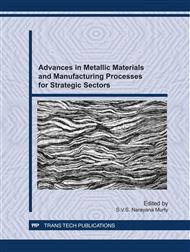p.270
p.276
p.285
p.291
p.297
p.303
p.308
p.314
p.320
Comparisons of Sintered Technology with Powder Forging for Fe-P Soft Magnetic Alloys
Abstract:
Sintered P/M ferrous compacts containing up to 0.8% phosphorous have attractive set of mechanical and magnetic properties. Large phosphorous additions increase the shrinkage during sintering to such a degree that the tolerances of the sintered component may become adversely affected. Further, the sintering process requires more time and energy and is hence costly. To overcome the above problems, powder forging route has been used. In this process encapsulated Fe- P based alloy powder is heated and forged it into slabs. These were hot rolled to produce sheet and wires. Phosphorous addition improves the final density of the resulting product. It also improves the soft magnetic properties. All the alloys exhibited excellent workability.
Info:
Periodical:
Pages:
297-302
Citation:
Online since:
January 2012
Keywords:
Price:
Сopyright:
© 2012 Trans Tech Publications Ltd. All Rights Reserved
Share:
Citation:


